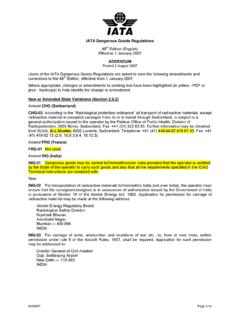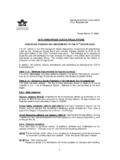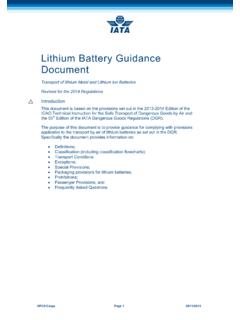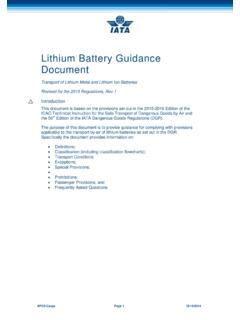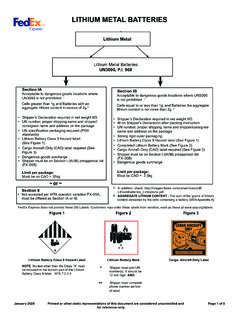Transcription of KINOSHITA AVIATION CONSULTANTS - …
1 1 KINOSHITA AVIATION CONSULTANTS Website: 201611=1: $! #RA42< (20161 E57B03) ? "% 6O $! #RA42< DC 201619G IATA Dangerous Goods Regulations 57th Edition (DGR) ,; $! #RA + 5 H. IN & IATA lithium battery Shipping guidance (LBSG - $! #RAPQ42<) (/ J H) S- @ :>M FL *8 7' K lithium battery guidance document Transport of lithium Metal and lithium Ion Batteries Revised for the 2016 Regulations Introduction The purpose of this document is to provide guidance for complying with provisions applicable to the transport by air of lithium batteries as set out in the 57th Edition of the IATA Dangerous Goods Regulations (DGR).
2 The provisions of the DGR with respect to lithium batteries may also be found in the IATA lithium battery Shipping Guidelines (LBSG). In addition to the content from the DGR, the LBSG also has additional classification flowcharts and detailed packing and documentation examples for lithium batteries. Information on the DGR and LBSG can be found here: Specifically the document provides information on: x Definitions; x Frequently Asked Questions.. 2016 lithium battery guidance document 7 January 2016 Definitions lithium battery The term lithium battery refers to a family of batteries with different chemistries, comprising many types of cathodes and electrolytes.
3 For the purposes of the DGR they are separated into: lithium metal batteries. Are generally primary (non-rechargeable) batteries that have lithium metal or lithium compounds as an anode. lithium metal batteries are generally used to power devices such as watches, calculators, cameras, temperature data loggers Note: lithium metal batteries packed by themselves (not contained in or packed with equipment) (Packing Instruction 968) are forbidden for transport as cargo on passenger aircraft). Figure 1 - Example of lithium Metal Batteries lithium -ion batteries (sometimes abbreviated Li-ion batteries). Are a type of secondary (rechargeable) battery commonly used in consumer electronics.
4 Also included within the category of lithium -ion batteries are lithium polymer batteries. lithium -ion batteries are generally found in mobile telephones, laptop computers, etc. Figure 2 - Example of a lithium Ion battery Note: With effect 1 April 2016 lithium ion batteries packed by themselves (Packing Instruction 965) (not contained in or packed with equipment) must be shipped at a state of charge (SoC) not exceeding 30% of their rated design capacity. Cells and/or batteries at a SoC of greater than 30% may only be shipped with the approval of the 2016 lithium battery guidance document 7 January 2016 State of Origin and the State of the Operator under the written conditions established by those authorities.
5 Cells and/or batteries at a SoC of greater than 30% may only be shipped with the approval of the State of Origin and the State of the Operator under the written conditions established by those authorities. The technical definition of a battery and cell, as indicated in the UN Manual of Tests and Criteria, is as follows: battery means two or more cells which are electrically connected together and fitted with devices necessary for use, for example, case, terminals, marking and protective devices. A single cell lithium battery is considered a "cell" and must be tested according to the testing requirements for "cells" for the purposes of these Regulations and the provisions of subsection of the UN Manual of Tests and Criteria (see also the definition for "cell").
6 Note: Units that are commonly referred to as battery packs , modules or battery assemblies having the primary function of providing a source of power to another piece of equipment are for the purposes of these Regulations and the provisions of Subsection of the UN Manual of Tests and Criteria treated as batteries. Cell means a single encased electrochemical unit (one positive and one negative electrode) which exhibits a voltage differential across its two terminals. Under these Regulations and the UN Manual of Tests and Criteria, to the extent the encased electrochemical unit meets the definition of cell herein, it is a cell , not a battery , regardless of whether the unit is termed a battery or a single cell battery outside of these Regulations and the UN Manual of Tests and Criteria Button cell or battery means a round small cell or battery when the overall height is less than the diameter.
7 Power Bank (power pack, mobile battery , etc.). No formal definition exists and there continues to be discussion at the United Nations Subcommittee of the correct classification for transport. However, for the purposes of this guidance document and the IATA Dangerous Goods Regulations powers banks are to be classified as batteries and must be assigned to UN 3480, lithium ion batteries, or UN 3090, lithium metal batteries, as applicable. For carriage by passengers, power banks are considered as spare batteries and must be in carry-on baggage only and must be individually protected from short-circuit. Classification (DGR ) lithium batteries are classified in Class 9 Miscellaneous dangerous goods as: x UN 3090, lithium metal batteries; and x UN 3480, lithium ion batteries or, if inside a piece of equipment or packed separately with a piece of equipment as: x UN 3091, lithium metal batteries contained in equipment; or x UN 3091, lithium metal batteries packed with equipment; and x UN 3481, lithium ion batteries contained in equipment; or x UN 3481, lithium ion batteries packed with equipment.
8 2016 lithium battery guidance document 7 January 2016 In the absence of exceptions, these batteries must be shipped in quantities that comply with the limitations contained in the DGR (see DGR Table and the applicable packing instruction). They must be contained in a UN specification packaging as prescribed by the applicable packing instruction in the DGR. A completed package must display a Class 9 hazard label in addition to markings that identify the applicable proper shipping name and UN number. A shipper must document the shipment using a Shipper s Declaration for Dangerous Goods. The classification criteria for lithium batteries stipulates that cells and batteries must be manufactured under a quality management program.
9 DGR (LBSG ) includes the elements that must be included in such a program. Frequently Asked Questions Part 1 Questions Related to Definitions A. What are the various types of lithium batteries? lithium batteries fall into two broad classifications; lithium metal batteries and lithium ion batteries. lithium metal batteries are generally non-rechargeable and contain metallic lithium . lithium ion batteries do not contain metallic lithium and are rechargeable. B. What are lithium polymer batteries? A lithium polymer battery is a type of lithium ion battery . Generally, the main difference is lithium ion polymer batteries contain a polymer electrolyte.
10 C. What is the difference between a lithium cell and a lithium battery ? A lithium cell is a single encased electrochemical unit consisting of one positive and one negative electrode that exhibits a voltage differential across the two terminals. A lithium battery is two or more cells electrically connected. A single cell battery is considered a cell and not a battery for the purposes of the limitations set out in the DGR. Note: Units that are commonly referred to as battery packs having the primary function of providing a source of power to another piece of equipment are for the purposes of these Regulations treated as batteries.

